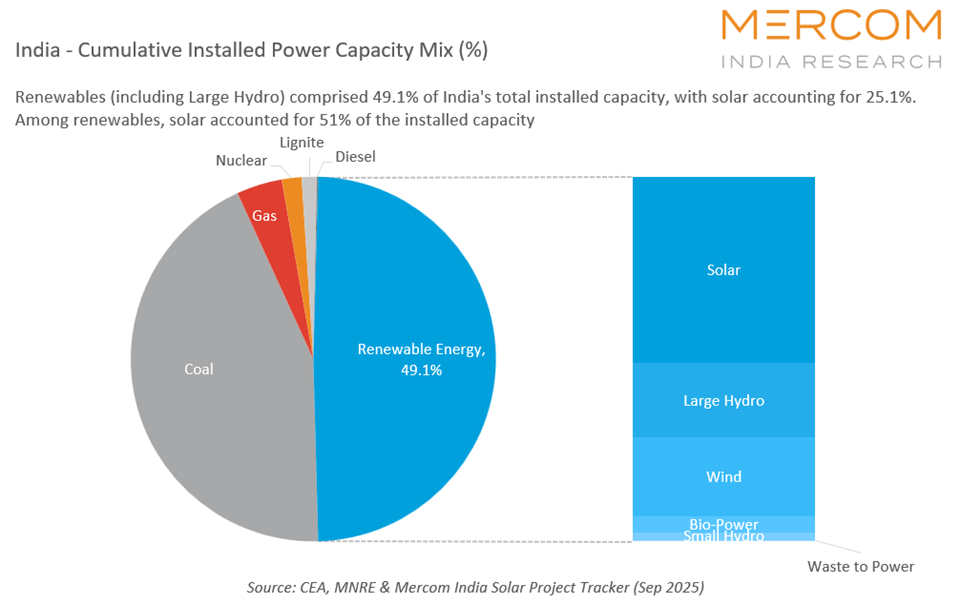51% of India’s Installed Renewable Capacity was Solar by Q3 2025
Renewables accounted for a 49.1% share of the overall power capacity mix
November 7, 2025
Follow Mercom India on WhatsApp for exclusive updates on clean energy news and insights
Solar power accounted for 25.1% of India’s total installed power capacity and 51% of the total installed renewable capacity as of September 2025. The solar capacity installed increased by 7.5% quarter-over-quarter (QoQ) and 37.5% year-over-year (YoY).
India’s renewable energy capacity, including large hydroelectric projects, made up 49.1% of the country’s cumulative power capacity, with 245.1 GW installed at the end of the third quarter of 2025, according to data from the Central Electricity Authority (CEA), the Ministry of New and Renewable Energy (MNRE), and Mercom’s India Solar Project Tracker.
In Q2 2025, renewable energy installations were at 234.2 GW, representing 48.3% of the overall power capacity mix. In Q3 2024, the installations totaled 201.6 GW, accounting for 40.4% of the overall power capacity mix.

India generated approximately 38 billion units (BU) of solar power in Q3 2025, marking a 20.4% YoY increase. On a QoQ basis, generation dropped by 11%, up from 43 BU in the previous quarter.
Wind, with a total installed capacity of 53.1 GW, accounted for nearly 10.7% of the cumulative installed power capacity as of September 2025.
Large hydro contributed 10% to the power mix as of September 2025, with 50.1 GW, up 1.5% from the previous quarter.
Biomass and small hydro contributed 2.2% and 1% to the total installed power capacity as of September 2025, respectively.
Energy from conventional sources
At the end of Q3 2025, the country’s installed conventional power capacity stood at 253.6 GW, accounting for 50.9% of the total installed power capacity. In Q2 2025, the share of conventional power in the overall power mix was 51.7%, compared with 55.5% in Q3 2024.
Electricity generation from thermal sources remains dominated by coal (43.6%), followed by gas (4%), nuclear (1.8%), lignite (1.3%), and diesel (0.12%). Although the overall installed capacity of conventional power declined during the quarter, coal-based capacity increased due to the commissioning of THDC’s Khurja Super Thermal Power Plant, Unit 2 (660 MW), in Uttar Pradesh.
A total of 6,495.84 MW of conventional capacity was temporarily decommissioned in Q2 2025 and will be reinstated once the generating units notify the Central Electricity Authority (CEA). However, no such decommissioning took place in Q3 2025.
While conventional power continues to hold the majority share in total installed capacity, its declining share reflects the rapid expansion of renewable energy across the country.
Recently, MNRE clarified that there will be no blanket cancellation of projects awarded by renewable energy implementing agencies (REIAs) where power sale agreements (PSAs) remain unsigned. REIAs have been directed to categorize projects based on their likelihood of securing PSAs with end procurers, considering factors such as configuration of renewable supply, discovered tariffs, and connectivity timelines.
Recently, the Ministry of Power, in collaboration with the Bureau of Energy Efficiency (BEE), has issued a notification amending the Energy Conservation Act of 2001 to introduce minimum renewable energy consumption targets for designated consumers until FY 2029-2030.
During the Mercom India Renewables Summit 2025, Sudeep Jain, Additional Secretary, MNRE, stated that India has set a target of achieving 1,800 GW of renewable energy capacity by 2047 to meet its increasing power demand.
